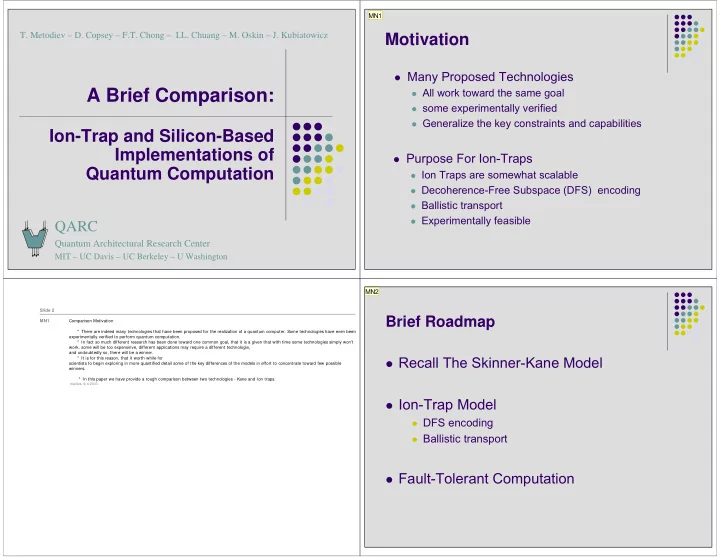

MN1 T. Metodiev – D. Copsey – F.T. Chong – I.L. Chuang – M. Oskin – J. Kubiatowicz Motivation � Many Proposed Technologies � All work toward the same goal A Brief Comparison: � some experimentally verified � Generalize the key constraints and capabilities Ion-Trap and Silicon-Based Implementations of � Purpose For Ion-Traps Quantum Computation � Ion Traps are somewhat scalable � Decoherence-Free Subspace (DFS) encoding � Ballistic transport � Experimentally feasible QARC Quantum Architectural Research Center MIT – UC Davis – UC Berkeley – U Washington MN2 Slide 2 Brief Roadmap MN1 Comparison Motivation * There are indeed many technologies that have been proposed for the realization of a quantum computer. Some technologies have even been experimentally verified to perform quantum computation. * In fact so much different research has been done toward one common goal, that it is a given that with time some technologies simply won't work, some will be too expensinve, different applications may require a different technologie, and undoubtedly so, there will be a winner. � Recall The Skinner-Kane Model * It is for this reason, that it worth while for scientists to begin exploring in more quantified detail some of the key differences of the models in effort to concentrate toward few possible winners. * In this paper we have provide a rough comparison between two technologies - Kane and Ion traps. marlies, 6/4/2003 � Ion-Trap Model � DFS encoding � Ballistic transport � Fault-Tolerant Computation
Slide 3 MN2 Brief Overview: Skinner-Kane (SK) 1. Why Compare Ion Traps and Kane, * We have done much research into the Kane technology. * Kane is based on Slicon, and Ion-Traps have a prospect of silicon * marlies, 6/4/2003 T = ~100 mK B AC -Gates S -Gates A B Barrier 28 Si e- 31 e- P + P + 31 Substrate Skinner 02’ Ion-Traps Inter-Connected Ion Traps QCCD : Lasers Quantum Charge-Coupled Device Linear RF Trap • Qubits are held in the hyperfine interaction between the nuclear and electronic spin. • Gates: light induced coupling. • Information exchange is done by Coulombic Interactions between ions and an ion head. • Problems with this approach. Silicon Wafers Cirac and Zoller, 95’ Kielpinski 02’
Fault-Tolerant Error Correction DFS Encoded Qubit α : collective dephasing � Qubits Must be Encoded To Protect States + � Errors Must Be Uncorrelated and = = � Kane - avoidance, Ions - prevention α + α Lowest Level Encoding Second Level Encoding � Ion Traps � Ion Traps � Steane [[7,1,3]] code � DFS encoding To Data Qubits � Corrected through SM gate pulses Encoded � Skinner Kane Model Zero Verification Of Encoded Zero State Creation � Steane [[7,1,3]] code � Skinner Kane Model � Steane [[7,1,3]] X [[7,1,3]] code Steane 96’ Upper Level Codes are Recursive to the Lower Levels
Architectural Features Transport – Static vs . Dynamic • Ion-Traps � Skinner-Kane (Static) • High Parallelism • Trapping electrodes need not be very large � Neighbor-to-Neighbor Swaps – 0.15m/s • Ions must be at least 10µm apart Classical Gates e 1 e 2 • Skinner Kane Gate • qubits are 15-100 nm apart � Ion-Traps (Dynamic) • T < 1K (Big Problem for Classical Gates) � Ballistic Transport – 10m/s 10nm Quick Analysis Conclusion Operator Silicon Ion-Trap SWAP 0.57 µs 6 µs � Alternative Approaches to Transport 0.15 m/s 10 m/s Entangl. 4 µs 1 µs Error Correction CNOT 3.2 µs 2 µs Rotation ≤ 0.3 µs ≤ 24 µs Hadamard 0.1 µs 1.5 µs � Future Work * Ion Total Cost : ~ 400 µs * Skinner-Kane Cost: ~ 4500 µs
Ion-Traps QCCD Quantum Charge-Coupled Device Cross View (Silicon Wafers) RF RF Be + DC DC RF RF
Recommend
More recommend